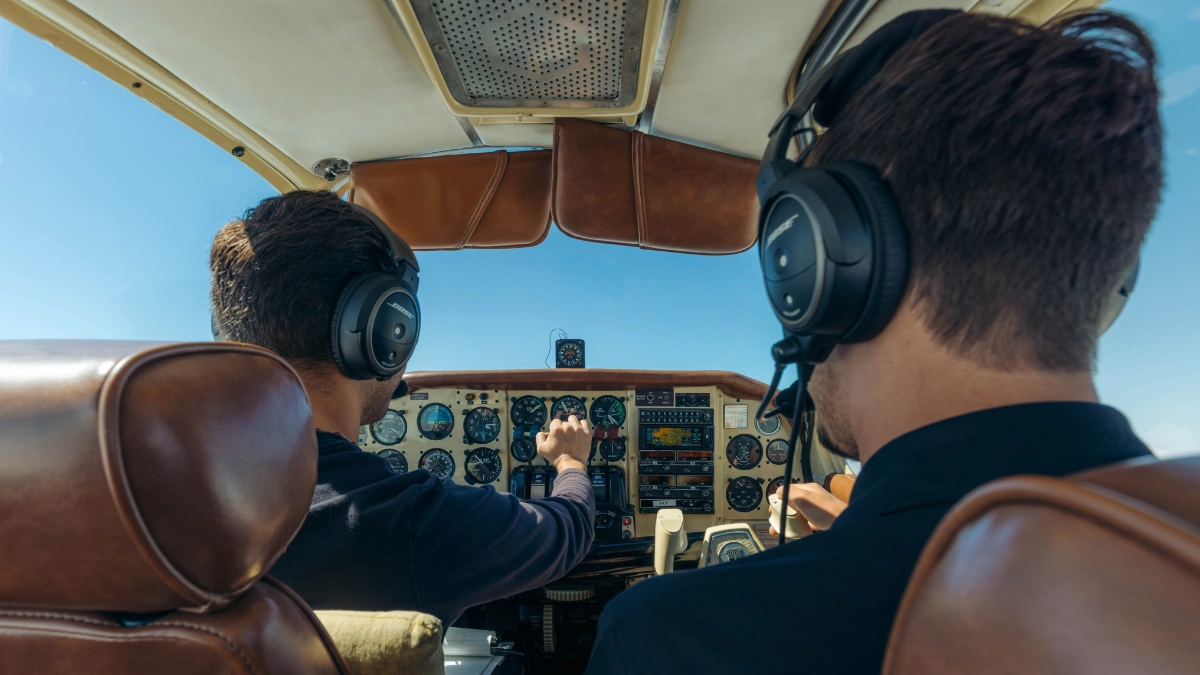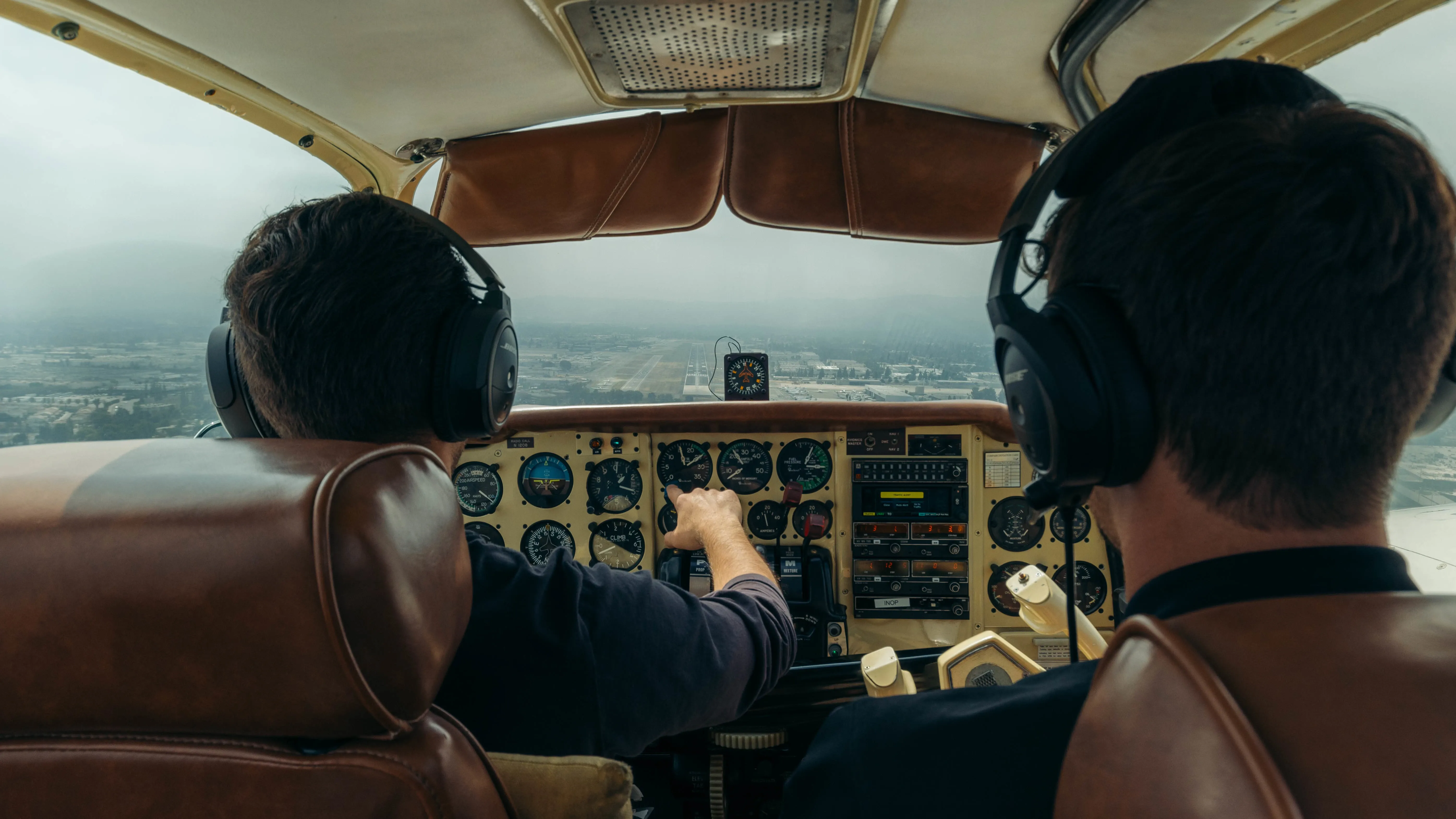
The 5 Most Common Student Pilot Mistakes (And How to Master Them)
Published by: Alex Feldman
Every great pilot started as a student who learned from their mistakes. Here’s how to turn common challenges into stepping stones toward aviation excellence.
The first time you take the controls of an aircraft, the world looks different from 3,000 feet. The excitement is intoxicating, but let’s be honest—flight training can also feel overwhelming. Between managing instruments, communicating with air traffic control, and actually flying the plane, there’s a lot to master.
At LA Flight Academy, we’ve guided hundreds of aspiring pilots through their training journey. Our experienced instructors have seen it all, and they’ve identified patterns in the challenges students face. The good news? These common mistakes are completely avoidable once you know what to watch for.
Whether you’re considering your first discovery flight or you’re already deep into training, understanding these five pitfalls will accelerate your progress and build the foundation for a lifetime of safe flying.
1. The “Death Grip” Problem: Overcontrolling Your Aircraft
What it looks like: You’re white-knuckling the yoke, making constant corrections, and the aircraft feels like it’s fighting you every step of the way.
Picture this: You’re on your third lesson, and every time the nose drops slightly, you yank back on the controls. When the wing dips, you immediately counter with aileron input. The result? A flight that feels more like a mechanical bull ride than smooth aviation.
Why it happens: Your brain is wired for survival, and when you’re learning something as foreign as flying, it screams “DO SOMETHING!” every time the aircraft moves. This hypervigilance, while natural, works against the physics of flight.
The fix: Aircraft are designed to be stable. They want to fly straight and level. Your job isn’t to fight the airplane—it’s to guide it.
Start by loosening your grip (literally). Use your fingertips, not your whole hand. Make small, deliberate inputs and then wait for the aircraft to respond. Think of it like steering a large boat rather than driving a go-kart.
Most importantly, learn to use trim effectively. Trim is your best friend for reducing control pressure and maintaining stable flight. At LA Flight Academy, we teach students to “trim to relieve pressure” as a fundamental technique that separates smooth pilots from those who struggle through every flight.
2. The Speed Trap: Airspeed Management Mistakes
What it looks like: Your airspeed indicator is bouncing around like a pinball, and you’re constantly chasing the target speed.
Airspeed is the foundation of safe flight, yet it’s often the first thing students lose track of when task-saturated. Too slow, and you risk a stall. Too fast, and you’re putting unnecessary stress on the aircraft and making precise control difficult.
Why it happens: When you’re trying to navigate, talk on the radio, and watch for traffic simultaneously, airspeed monitoring can fall by the wayside. It’s a classic case of task prioritization—and airspeed often loses.
The master solution: Develop your instrument scan early and make it automatic. Your eyes should flow naturally: attitude indicator, airspeed, altitude, heading, then back to attitude. This isn’t just about looking at the instruments—it’s about processing and acting on the information.
Learn your aircraft’s key speeds by heart:
- Vx (best angle of climb): For clearing obstacles
- Vy (best rate of climb): For gaining altitude quickly
- Vref (reference landing speed): For consistent approaches
Pro tip: Use your other senses too. Engine sound, control feel, and even the wind noise all provide airspeed cues. Experienced pilots develop this intuitive sense, but it starts with deliberate practice during training.
3. Radio Anxiety: Conquering Communication Challenges
What it looks like: Your heart rate spikes when the radio crackles, and you stumble over standard phraseology.
Radio communication intimidates many student pilots, especially when training at busy airports like Van Nuys (KVNY), where LA Flight Academy operates. The rapid-fire communications and aviation jargon can feel like learning a foreign language while trying to fly an airplane.
Why it happens: Radio work is a skill completely separate from aircraft control, yet you’re expected to do both simultaneously. Add in the pressure of knowing other pilots are listening, and it’s easy to become tongue-tied.
The confidence builder: Start building radio skills on the ground. Listen to LiveATC.net during your free time—specifically Van Nuys Tower—to familiarize yourself with local controllers and common phraseology.
Practice standard calls out loud:
- “Van Nuys Tower, Cessna 12345, ready for departure, runway 16 right”
- “Van Nuys Tower, Cessna 12345, left downwind, runway 16 right”
- “Van Nuys Tower, Cessna 12345, request full stop, runway 16 right”
At LA Flight Academy, we use FAA-approved simulators to practice radio procedures in a no-pressure environment. Students can make mistakes, ask questions, and build confidence before they’re managing both radio calls and aircraft control simultaneously.
Remember: Controllers want to help you succeed. They’d rather have you ask for clarification than guess what they meant.
4. The Rushing Trap: Inadequate Pre-Flight Preparation
What it looks like: You show up, rush through the preflight inspection, and launch into flight without proper planning.
Every professional pilot will tell you the same thing: flights are won or lost on the ground. Yet many students treat pre-flight preparation as a hurdle to overcome rather than a critical safety practice.
Why it happens: The airplane is the exciting part, right? Sitting in a classroom reviewing weather reports and calculating weight and balance feels like busywork when you could be flying.
The professional approach: Great pilots treat every flight like a mission. This means thorough preparation becomes as automatic as breathing.
Your pre-flight routine should include:
- Weather analysis (not just “looks good”)
- NOTAM review (especially for your departure and arrival airports)
- Weight and balance calculations (every time, not just for checkrides)
- Aircraft inspection (methodical, not rushed)
- Flight plan review (mental rehearsal of the entire flight)
Use modern tools like ForeFlight, but understand the fundamentals behind them. At LA Flight Academy, we teach students to embrace preparation as a professional habit that will serve them throughout their flying career.
5. The Feedback Resistance: Not Maximizing Instructor Guidance
What it looks like: You get defensive when your instructor provides correction, or you keep making the same mistakes repeatedly.
Learning to fly is intensely personal. You’re pushing your comfort zone, managing complex tasks, and trying to meet high standards. When an instructor points out areas for improvement, it can feel like personal criticism.
Why it happens: Flight training is challenging, and it’s natural to want to defend your efforts. Some students also fall into the trap of thinking they should “get it” immediately.
The growth accelerator: The best student pilots we see at LA Flight Academy share one characteristic: they’re feedback seekers, not feedback avoiders.
After each lesson:
- Ask specific questions: “What’s the one thing I should focus on for next time?”
- Take notes: Write down key points while they’re fresh
- Practice mentally: Review the lesson and visualize improvements
- Come prepared: Show up to the next lesson with questions and a plan
Remember, your instructor wants you to succeed. They’ve seen hundreds of students work through the same challenges you’re facing. Their feedback isn’t criticism—it’s a roadmap to improvement.
Your Path to Aviation Excellence
These five mistakes aren’t character flaws—they’re normal parts of the learning process. The difference between students who struggle and those who excel isn’t natural talent; it’s how they respond to challenges.
At LA Flight Academy, we’ve built our training programs around helping students navigate these common pitfalls. Our experienced instructors provide personalized guidance, our modern training aircraft are maintained to the highest standards, and our location at Van Nuys Airport offers real-world experience in controlled airspace.
Whether you’re just starting to dream about becoming a pilot or you’re ready to begin your training journey, we’re here to help you succeed. Our FAA Part 61 programs are designed to take you from zero experience to confident, skilled pilot.
Ready to start your aviation journey? Contact LA Flight Academy today to schedule your discovery flight. Let’s turn your dreams of flight into reality—safely, professionally, and with confidence.
LA Flight Academy is Southern California’s premier flight training school, located at Van Nuys Airport. We’re committed to training safe, skilled pilots through personalized instruction and professional-grade aircraft. Learn more about our programs and schedule your discovery flight at laflightacademy.com.
